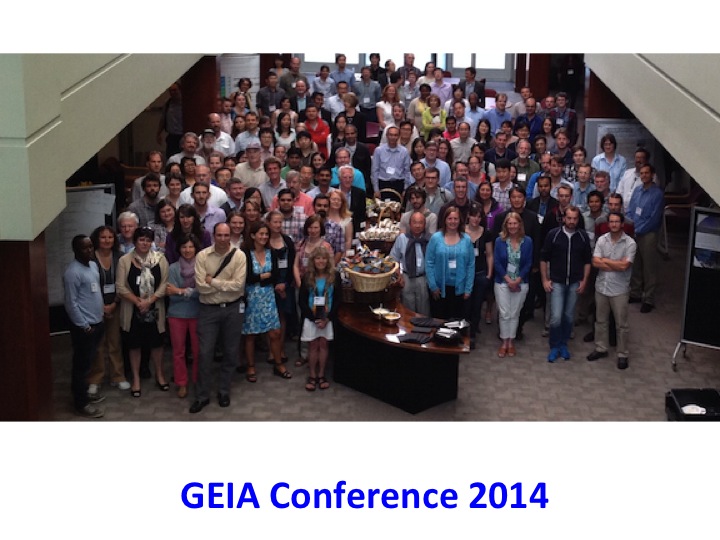GEIA 2014
16th GEIA Conference - Bridging Emissions Science and Policy
10-11 June 2014
National Center for Atmospheric Research, Boulder, Colorado, USA
Paulette Middleton, Panorama Pathways, Boulder, Colorado, USA (paulette@panoramapathways.net)
Gregory Frost, NOAA/ESRL and University of Colorado/CIRES, Boulder, Colorado, USA (gregory.j.frost@noaa.gov)
Leonor Tarrasón, Norwegian Institute for Air Research (NILU), Kjeller, Norway (leonor.tarrason@nilu.no)
Claire Granier, LATMOS/IPSL, Paris, France; NOAA/ESRL and University of Colorado/CIRES, Boulder, Colorado, USA; Max Planck Institute for Meteorology, Hamburg, Germany (Claire.granier@latmos.ipsl.fr)
Jean-François Lamarque, NCAR, Boulder, Colorado, USA (lamar@ucar.edu)
The 16th GEIA Conference, a forum for exploring the role of emissions as a crucial link between scientific innovation and societal development, was organized around four questions:
- How are recent measurement advancements helping to better quantify emissions?
- What are new developments in emissions process understanding?
- What are challenges in interpreting past emissions trends and projecting future emissions?
- How does improved emissions knowledge inform critical societal issues?
Presentations, panels, demonstrations, and discussions involved about 200 participants from 6 continents representing a variety of stakeholder groups and highlighted progress and challenges in addressing these questions. Abstracts, presentations, and other conference materials can be found at http://www.geiacenter.org/community/geia-conferences/2014-conference.
The 16th Conference helped identify topics that will be further investigated over the next two years by the GEIA community, through working groups and collaborations, online discussion forums, and preparations for the 17th GEIA Conference. GEIA will be paying particularly close attention to the following issues in the next two years:
- Land Use. Tracking land use changes with satellites and ground-based observations is central to quantifying how these changes are driving emissions in different parts of the world.
- Fire Emissions. New multichannel satellites and extensive field measurements are enhancing assessments of emissions from wildfires, prescribed burning, and agricultural fires, enabling better characterization of sources, identifying smaller fire events, and quantifying waste burning as a potential source of toxic compounds.
- Energy Production. Extensive analysis of methane and hydrocarbon emissions from energy production and distribution, including conventional and unconventional extraction and leaks from abandon sites, is essential for informing choices about energy sources.
- Agricultural Emissions. Assessing the emissions of methane and reactive nitrogen, particularly ammonia, from agriculture and livestock remains an important challenge, and will benefit from more extensive deployment of in-situ measurements and better characterization of satellite information.
- VOC Speciation. Expanding direct measurements of individual volatile organic compounds (VOCs) remains critical for understanding the contributions of specific VOCs to ozone and fine particle production, exposure to toxics, and climate impacts.
- Asian Emissions. Recent significant progress validating Asian emissions should be extended to other parts of the world, such as Africa and South America. Continued quantification of emissions in this rapidly developing part of the world is essential.
- Urban Areas. Ambient air monitoring and roadside sampling combined with fuel usage and traffic density accounting improves the quantification and resolution of emissions in cities, demonstrates the benefits of vehicle emissions controls, and provides constraints on regional and global inventories.
- Historical Emissions. GEIA is leading an effort to quantify global emission trends over the past 250 years and to harmonize them with future emissions projections. Open-source systems are being developed to allow updates and to assess uncertainties in historical inventories.
- Closing Gaps. Field campaigns, satellite data, and direct source measurements in more regions of the world are providing essential information for improving emission factors and quantifying emissions at a basin level, with the goal of narrowing the discrepancies between bottom-up inventories and top-down approaches relying on observations.
Tighter pollution standards aimed at protecting human health, coupled with rapid societal and land use changes, have increased the urgency for producing accurate, comprehensive, and harmonized emissions datasets. GEIA community members serve as sentinels, translators, and communicators of emissions and their impacts. By sharing, analyzing, and synthesizing up-to-date emissions knowledge, GEIA informs regulators and policy-makers engaged in environmental protection, pollution mitigation, and adaptation strategies, and increases the capacity for understanding emissions around the world.
